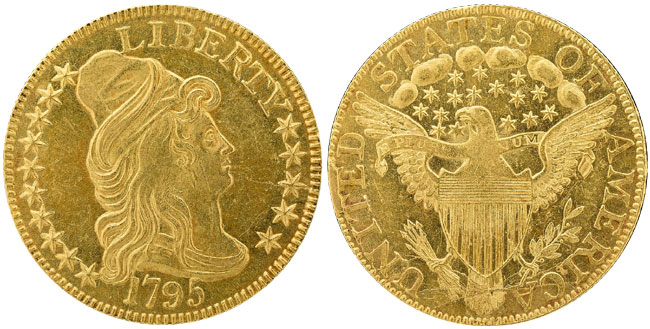Guide to U.S. Draped Bust Half Eagles
The half eagle holds an important place in history as the first gold coin officially struck by the United States Mint. The initial series would come to be known as the Draped Bust Half Eagle, with the design sometimes referred to as “Turban Head” or “Capped Bust to Right.” Delivery of the first coins would take place on July 31, 1795 and the series would continue until 1807 across two different subtypes. The series boasts several rare issues and two varieties which are each represented by only a single known specimen.

The Coinage Act of 1792 established three gold denominations known as the quarter eagle, half eagle, and eagle, with face values of two dollars and fifty cents, five dollars, and ten dollars, respectively. The half eagle was produced first, followed by the eagle, and then the quarter eagle. In 1804, President Thomas Jefferson would halt the production of eagles, leaving the half eagle as the coin of choice for large domestic and overseas transactions. In everyday commerce, the coins were rarely encountered as the value of a single coin represented such a significant amount of money at the time.
The Draped Bust Half Eagle was designed by Robert Scot, the first Chief Engraver of the United States Mint. The series can be divided into two different subtypes identified by the different reverse designs. The common obverse design features the bust of Liberty, facing right. She wears a Phrygian or Freedom Cap, with her long and curling hair seen extending beneath. A small part of her drapery is visible, slightly above the truncation of her neck. Stars are in front of and behind Liberty, with various counts and arrangements used throughout the series. The inscription LIBERTY appears above the cap, with the date below.
The first reverse design, known as the “small eagle reverse,” is found on coins dated from 1795 to 1798. A relatively slim bald eagle is shown, perched on a palm branch with its wings spread. Its beak holds a circular wreath containing a number of small berries in various counts. The inscription UNITED STATES OF AMERICA appears surrounding. As with other early gold coinage, there is no indication of the denomination within the design.

The second reverse design, known as the “heraldic eagle reverse,” is found on coins dated from 1795 to 1807. The eagle is based on the Great Seal of the United States and shown with its wings spread and a shield at its breast. The eagle’s talons separately grasp a bundle of arrows and an olive branch, while its beak holds a scroll containing the motto E PLURIBUS UNUM. A number of stars ranging in count from thirteen to sixteen appear between the eagle’s head and an arc of clouds above. The inscription UNITED STATES OF AMERICA appears surrounding.
The new reverse design was introduced in 1797, but earlier dated coins were created due to the pairing with leftover obverse dies as a cost savings measure. Similarly, later dated coins are found with the small eagle reverse due to the use of an old reverse die paired with a new 1798-dated obverse die.

